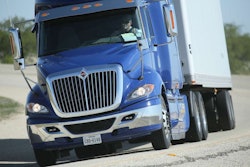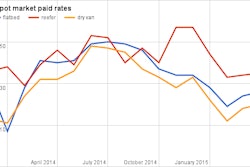 Worldwide shifts in freight patterns, combined with infrastructure changes like smart highways, connected vehicles and super bridges, will make trucking a truly globalized industry. Learn more about what the trucking industry could look like in the coming decades — and how your fleet can adapt — at the CV-Outlook conference later this month.
Worldwide shifts in freight patterns, combined with infrastructure changes like smart highways, connected vehicles and super bridges, will make trucking a truly globalized industry. Learn more about what the trucking industry could look like in the coming decades — and how your fleet can adapt — at the CV-Outlook conference later this month.Trucking has always had a strained relationship with technology. On one hand, technology allows trucking to exist and perform as required. On the other hand, technology is expensive and the learning curves can be steep.
For a long time, simply opting out was a pretty solid business when it came to new technology in trucking. If your trucks were a year or two old, and you were on a long-term trade cycle, if something new came out, it was perfectly fine to let the other guys wrestle with it and figure out how to make it work while your faithful old rigs kept right on roaring down the road.
In an age of cheap fuel, the competitive advantages of new technology were often minimal. Moreover, when the time came to refresh your fleet, you could simply leverage what your competitors had already learned and integrate new technology into your operations fairly easily.
Those days are pretty much dead and gone. The incredible consumer-side tech push that started in the 1970s has finally caught up with trucking. Everything’s wired together, sensors are everywhere, communication is constant and the government is pushing new technology on fleets the minute it becomes commercially viable. There are new fuels and battery systems to contend with. And all the while, a new Internet-fueled global super economy is forcing ever faster and leaner operations from fleets.
In short, the future is here, and trucking can no longer opt out.
Upcoming Event

Trucking’s Future Now
Don’t get left behind. Learn critical information about the future of the trucking industry at the Commercial Vehicle Outlook.
Explore CV Outlook →
If you’re a fleet manager, your second, immediate thought was, “How in the hell are we going to deal with all this stuff?”
Maybe CCJ can help.
At the end of this month, we’ll be in Dallas ahead of the Great American Trucking Show at CV-Outlook. Usually, industry conferences cover a huge swath of issues, but this one will be different: The encompassing theme of CV-Outlook this year is simply the future. Specifically, the future of trucking.
CCJ editors have spent the past several weeks talking to renowned thinkers and futurists from both inside and outside the trucking industry to paint as realistic a picture as possible regarding the amazing new technologies and trends that are rapidly coming our way – always with an emphasis on how change the trucking and logistics landscape over the next 25 to 50 years.
On top of that, this fall will see a big cross-platform package from all Randall-Reilly trucking brands, including CCJ and Overdrive, that will look at every aspect of future fleet and trucking operations – from drivers and technicians all the way up to shifting global freight patterns and new demographic trends.
Upcoming Event

The Titans of Trucking
Join trucking’s Market Movers for a discussion on how E-commerce is changing the transportation industry and strategies going forward.
Be a Market Mover →
And even though I’ve been focused on future tech and writing about it for some time, I have to say that some of the predictions I’ve heard over the past few weeks simply defy belief. Here’s just a taste:
The Fitbit and other health wearables will be replaced by a “smart” contact lens. When you wear the lens, you’ll get all your health data presented in your regular line of vision – just like a heads-up display beaming vehicle information onto a windshield.
Three-dimensional printing machines, using multiple materials will be everywhere and “manufacturing” everything from scratch: They’ll scan your body and print clothes fitted exactly to your body shape; they’ll build whole houses with the electrical wiring and plumbing already in place, put roofs on existing houses. And when your technicians need a part they’ll enter the code and the machine will make will build it right there in the shop.
Super highways filled with autonomous trucks will connect every point on the globe. It will be possible to start a trip in Terra del Fuego in Argentina, drive the length of South and North America, cross new bridges spanning Bering Sea into Russia, continue on to Spain, cross another new Super Bridge at Gibraltar and drive on down to Capetown, South Africa. Or, if you like, you could take a left and head down to Korea and cross the new bridge into Japan.
Freight will change: As 3D printers become common, you’ll move from hauling finished goods to hauling more and more raw materials. Moreover, as the rising global economy and connected world creates new middle classes in places like Africa and India, the United States will emerge as the most important food-producing nation on the planet. Efficiently moving food products around the world will create incredible wealth both for the country as a whole and trucking as an industry.
You’ll own your trucks. But the powertrains in them will belong to the OEM. You’ll have a powertrain contract guaranteeing you maximum uptime and efficiency with those drivetrains. All upgrades and any new technology will be automatically downloaded or installed as they come available or are mandated by law.
Drivers’ seats in trucks will double as medical monitoring devices. If a driver is tired, if they are in a road-rage incident with an elevated pulse or having a medical emergency, a fleet will know in real time. Moreover, the fleet will be able to take control of the truck away from the driver and pull it off the road or route it to an alternate location (such as a hospital) in an emergency.
There’s a lot more, of course. But the most important take-away is this: Every single expert and futurist we talked to in the course of putting this future package together was bullish on the future of trucking. It is a vital industry that will only become more important for our sustained, global, economic growth over the next several decades. The challenges facing the industry will be enormous in the next few years. But the rewards will be as well.










